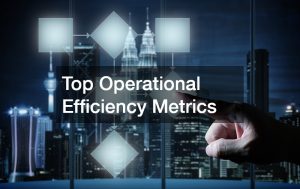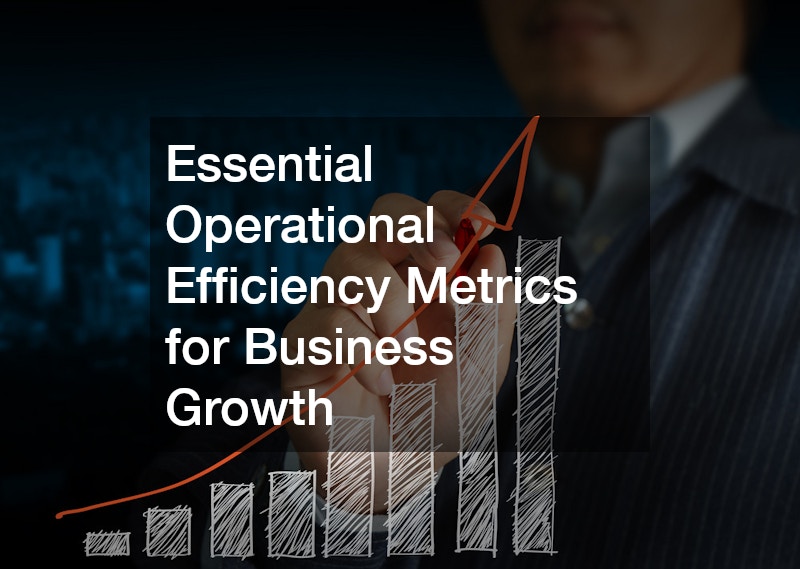Introduction
In today’s competitive business environment, achieving operational efficiency is crucial for sustained growth and success. Understanding and leveraging operational efficiency metrics can provide invaluable insights into how effectively your business is running. These metrics help in identifying areas for improvement, optimizing resources, and making informed strategic decisions. This comprehensive guide explores essential operational efficiency metrics, their benefits, and how to use them to drive business growth.
What Are Operational Efficiency Metrics?
Operational efficiency metrics are quantitative measures used to assess how well a business utilizes its resources to produce goods or deliver services. They provide insights into the effectiveness and efficiency of various business processes and operations. Businesses can pinpoint inefficiencies, streamline processes, and enhance overall performance by analyzing these metrics.
Importance of Metrics
- Data-Driven Decisions: Metrics offer objective data that aid in making informed decisions rather than relying on gut feelings.
- Improved Productivity: By identifying inefficiencies, businesses can take steps to improve productivity and output.
- Cost Reduction: Metrics help in identifying areas where costs can be reduced without compromising quality.
- Enhanced Resource Allocation: Efficient use of resources ensures that every dollar spent contributes to the company’s growth.
Key Benefits of Tracking Operational Efficiency Metrics
Improved Decision Making
Metrics provide a clear picture of how different aspects of your business are performing. This data enables managers and executives to make informed decisions based on empirical evidence rather than intuition. For example, if a company identifies a high operating expense ratio, it can investigate and address the underlying causes to improve financial performance.
Increased Productivity
By monitoring productivity metrics such as revenue per employee or asset utilization, businesses can identify areas where productivity can be improved. For instance, if a company finds that its asset utilization rate is low, it can explore ways to optimize asset use or adjust its asset base to better meet production demands.
Cost Management
Operational efficiency metrics help control and reduce costs. For example, tracking the operating expenses ratio allows businesses to evaluate whether their spending is proportional to their revenue. By identifying and eliminating wasteful practices, companies can achieve significant cost savings.
Scalability
Efficient operations support business growth and scalability. Metrics such as order fulfillment cycle time or first-time fix rate can help businesses ensure they can meet increasing demands without sacrificing quality.
Top Operational Efficiency Metrics for Business Growth

1. Revenue per Employee
Definition: Revenue per employee measures the average revenue generated by each employee. It is a key indicator of workforce productivity.
Actionable Insight: To improve this metric, businesses can focus on enhancing employee skills through training, optimizing task allocation, and leveraging technology to boost productivity.
Calculation: Revenue per Employee=Total RevenueNumber of Employees\text{Revenue per Employee} = \frac{\text{Total Revenue}}{\text{Number of Employees}}
2. Operating Expenses Ratio (OER)
Definition: The operating expenses ratio compares a company’s operating expenses to its total revenue, indicating how much of the revenue is consumed by operating costs.
Actionable Insight: Reduce operating expenses by automating repetitive tasks, outsourcing non-core functions, or renegotiating supplier contracts.
Calculation: OER=Operating ExpensesTotal Revenue\text{OER} = \frac{\text{Operating Expenses}}{\text{Total Revenue}}
3. Inventory Turnover Ratio
Definition: This metric measures how efficiently inventory is managed by showing how often inventory is sold and replaced over a period.
Actionable Insight: Improve inventory turnover by adopting just-in-time inventory systems, optimizing reorder points, and reducing excess stock.
Calculation: Inventory Turnover Ratio=Cost of Goods SoldAverage Inventory\text{Inventory Turnover Ratio} = \frac{\text{Cost of Goods Sold}}{\text{Average Inventory}}
4. Asset Utilization
Definition: Asset utilization measures how effectively a business uses its assets to generate revenue.
Actionable Insight: Enhance asset utilization by minimizing idle time, improving maintenance practices, and optimizing asset deployment.
Calculation: Asset Utilization=Total RevenueTotal Assets\text{Asset Utilization} = \frac{\text{Total Revenue}}{\text{Total Assets}}
5. Customer Retention Rate
Definition: Customer retention rate measures the percentage of customers a company retains over a specific period.
Actionable Insight: Increase retention by improving customer service, offering loyalty programs, and personalizing customer interactions.
Calculation: Customer Retention Rate=(Number of Customers at End of Period−New Customers AcquiredNumber of Customers at Start of Period)×100\text{Customer Retention Rate} = \left(\frac{\text{Number of Customers at End of Period} – \text{New Customers Acquired}}{\text{Number of Customers at Start of Period}}\right) \times 100
6. First-Time Fix Rate (FTFR)
Definition: FTFR measures the percentage of issues resolved on the first attempt, reflecting the effectiveness of problem-solving processes.
Actionable Insight: Enhance FTFR by investing in employee training, improving troubleshooting procedures, and using high-quality tools and resources.
Calculation: FTFR=Number of Issues Resolved on First AttemptTotal Number of Issues\text{FTFR} = \frac{\text{Number of Issues Resolved on First Attempt}}{\text{Total Number of Issues}}
7. Production Downtime
Definition: Production downtime indicates the amount of time production is halted due to equipment failure or other disruptions.
Actionable Insight: Minimize downtime by implementing preventive maintenance schedules, using real-time monitoring systems, and improving equipment reliability.
Calculation: Production Downtime=Downtime HoursTotal Production Hours\text{Production Downtime} = \frac{\text{Downtime Hours}}{\text{Total Production Hours}}
8. Order Fulfillment Cycle Time
Definition: This metric measures the average time required to process and deliver an order from the moment it is placed.
Actionable Insight: Reduce cycle time by automating order processing, optimizing warehouse management, and improving supply chain logistics.
Calculation: Order Fulfillment Cycle Time=Order Processing Time+Shipping TimeNumber of Orders Fulfilled\text{Order Fulfillment Cycle Time} = \frac{\text{Order Processing Time} + \text{Shipping Time}}{\text{Number of Orders Fulfilled}}
9. Employee Productivity Rate
Definition: Employee productivity rate measures the output per employee over a specific period, reflecting overall workforce efficiency.
Actionable Insight: Boost productivity by providing performance incentives, offering skill development opportunities, and optimizing workflow processes.
Calculation: Employee Productivity Rate=Total OutputNumber of Employees\text{Employee Productivity Rate} = \frac{\text{Total Output}}{\text{Number of Employees}}
10. Gross Profit Margin
Definition: Gross profit margin shows the percentage of revenue that exceeds the cost of goods sold (COGS), indicating financial health.
Actionable Insight: Improve profit margins by reducing production costs, enhancing sales strategies, and increasing operational efficiencies.
Calculation: Gross Profit Margin=Revenue−Cost of Goods SoldRevenue\text{Gross Profit Margin} = \frac{\text{Revenue} – \text{Cost of Goods Sold}}{\text{Revenue}}
How to Measure and Track Operational Efficiency Metrics
Using Business Intelligence Tools
Overview: Business Intelligence (BI) tools are crucial in tracking and analyzing operational efficiency metrics. These tools provide real-time data, generate comprehensive reports, and offer insights into performance trends.
Popular Tools: Tools like Tableau, Power BI, and Google Data Studio are widely used for creating interactive dashboards and visualizing data. These tools help in monitoring key performance indicators (KPIs) and making data-driven decisions.
Actionable Insight: To leverage BI tools effectively, integrate them with your existing systems, customize dashboards to reflect your business’s specific needs, and train your team to utilize these tools for actionable insights.
Setting Benchmarking Standards
Overview: Benchmarking involves comparing your business’s performance against industry standards or competitors. It helps in setting realistic goals and measuring progress.
Actionable Steps: Establish benchmarks based on industry data, historical performance, and best practices. Regularly review and adjust benchmarks to reflect changes in business goals and market conditions.
Creating Dashboards for Real-Time Insights
Overview: Dashboards provide a visual representation of operational metrics, allowing for quick and easy access to critical data. They enable businesses to track performance, identify trends, and respond promptly to issues.
Actionable Insight: Build custom dashboards to monitor key metrics such as revenue per employee, inventory turnover, and customer retention. Ensure dashboards are updated regularly and tailored to the needs of different stakeholders.
Advanced Techniques for Enhancing Operational Efficiency
Leveraging AI for Operational Efficiency
Overview: Artificial Intelligence (AI) is increasingly being used to enhance operational efficiency by automating routine tasks, analyzing vast amounts of data, and providing predictive insights.
Actionable Insight: Implement AI solutions to streamline operations, such as predictive maintenance for equipment, automated data analysis for better decision-making, and AI-driven customer service tools to improve response times and satisfaction.
How Do You Measure Efficiency with AI?
Overview: AI can help measure efficiency by analyzing performance data and providing insights into operational processes. It can identify patterns, predict future trends, and highlight areas for improvement.
Actionable Insight: Integrate AI analytics into your performance measurement systems to gain deeper insights into operational efficiency. Use AI tools to track metrics, automate reporting, and enhance data accuracy.
The Impact of Operational Efficiency on Business Growth
Scaling Operations
Overview: Efficient operations are essential for scaling a business effectively. Metrics help identify bottlenecks and areas for improvement, facilitating smooth and sustainable growth.
Actionable Insight: Use efficiency metrics to streamline processes, enhance capacity, and optimize resource allocation. This approach supports scalability and ensures that growth does not compromise operational quality.
Cost Savings and Profit Maximization
Overview: Tracking operational efficiency metrics helps in identifying cost-saving opportunities and maximizing profits. Metrics reveal areas where expenses can be reduced and efficiencies can be gained.
Actionable Insight: Implement cost management strategies based on insights from metrics. Focus on optimizing workflows, reducing waste, and improving procurement practices to enhance profitability.
Customer Satisfaction
Overview: Efficient operations contribute to better customer service and satisfaction. Metrics related to order fulfillment, response times, and service quality directly impact customer experiences.
Actionable Insight: Monitor customer-centric metrics and implement improvements based on the data. Enhance service delivery, reduce errors, and ensure timely responses to boost customer satisfaction and loyalty.
Conclusion
Operational efficiency metrics are indispensable tools for businesses aiming to optimize performance, reduce costs, and drive growth. By understanding and utilizing these metrics effectively, businesses can make data-driven decisions, enhance productivity, and achieve long-term success. Embracing advanced technologies such as AI for operational efficiency further amplifies these benefits, providing deeper insights and facilitating continuous improvement. As you implement these metrics and techniques, you’ll be better positioned to navigate the complexities of business operations and achieve your growth objectives.
